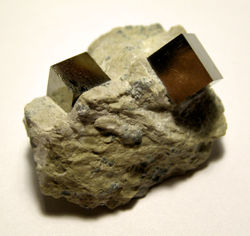Pyrite
2007 Schools Wikipedia Selection. Related subjects: Mineralogy
| Pyrite | |
|---|---|
 A mass of intergrown, striated pyrite crystals |
|
 Euhedral cubic pyrite crystals |
|
| General | |
| Category | Mineral |
| Chemical formula | iron disulfide (FeS2) |
| Identification | |
| Colour | Pale, dull gold |
| Crystal habit | Cubic, faces may be striated, but also frequently octahedral and pyritohedron. Often inter-grown, massive, radiated, granular, globular and stalactitic. |
| Crystal system | Isometric; bar 3 2/m |
| Melting Point | 1,177-1,188 °C |
| Cleavage | Poor |
| Fracture | Very uneven, sometimes conchoidal |
| Mohs Scale hardness | 6 - 6.5 |
| Luster | Metallic, glistening |
| Refractive index | Opaque |
| Streak | Greenish-black to brownish-black |
| Specific gravity | 4.95 - 5.10 |
| Fusibility | 2.5-3 |
| Solubility | insoluble in water |
| Magnetism | paramagnetic |
The mineral pyrite, or iron pyrite, is iron sulfide, FeS2. It has isometric crystals that usually appear as cubes. The cube faces may be striated (parallel lines on crystal surface or cleavage face) as a result of alternation of the cube and pyritohedron faces. Pyrite also frequently occurs as octahedral crystals and as pyritohedra (a dodecahedron with pentagonal faces). It has a slightly uneven and conchoidal fracture, a hardness of 6–6.5, and a specific gravity of 4.95–5.10. It is brittle, meaning it breaks or powders easily. Its metallic luster and pale-to-normal brass-yellow hue have earned it the nickname fool's gold, but ironically, small quantities of actual gold are sometimes found in pyrite. In fact, such auriferous pyrite is a valuable ore of gold.
Pyrite is the most common of the sulfide minerals. It is usually found associated with other sulfides or oxides in quartz veins, sedimentary rock and metamorphic rock, as well as in coal beds, and as the replacement mineral in fossils.
Pyrite exposed to the environment during mining and excavation reacts with oxygen and water to form sulfuric acid, resulting in acid mine drainage. This results from the action of Thiobacillus bacteria, which generate their energy by using oxygen to oxidize ferrous iron (Fe2+) to ferric iron (Fe3+). The ferric iron in turn reacts with pyrite to produce ferrous iron and sulfuric acid. The ferrous iron is then available for oxidation by the bacteria; this cycle can continue until the pyrite is exhausted.
Pyrite is used for the production of sulfur dioxide, e.g. for the paper industry, and in the manufacture of sulfuric acid, though such applications are declining in importance.
Pyrites can show negative resistance and have experimentally been used in oscillator circuits as radio detectors .
The name pyrite is from the Greek word "Pyr" meaning "fire". This is likely due to the sparks that result when pyrite is struck against steel. This capacity made it popular for use in early firearms such as the wheellock.
In her historical fiction book The Valley of Horses, Jean Auel's heroine Ayla is described as inventing a new method of creating fire by striking a pyrite-like material against flint.
Pyrite and marcasite
Pyrite is often confused with the mineral marcasite, a name derived from the Arabic word for pyrite, due to their similar characteristics. Marcasite is a polymorph of pyrite, which means it has the same formula as pyrite but a different structure and, therefore, different symmetry and crystal shapes. The formal oxidation states are, however, the same as in pyrite because again the sulfur atoms occur in persulfide-like pairs. Marcasite/pyrite is probably the most famous polymorph pair next to the diamond/ graphite pair.
Marcasite is metastable relative to pyrite and will slowly be changed to pyrite if heated or given enough time. Marcasite is relatively rare, but may be locally abundant in some types of ore deposits, such as Mississippi Valley-type Pb-Zn deposits. Marcasite appears to form only from aqueous solutions.
Pyrite is often used in jewellery such as necklaces and bracelets, but although the two are similar, marcasite cannot be used in jewellery as it has a tendency to crumble into powder. Adding to the confusion between marcasite and pyrite is the use of the word marcasite as a jewellery trade name. The term is applied to small polished and faceted stones that are inlaid in sterling silver, but even though they are called marcasite, they are actually pyrite.
Formal oxidation states for pyrite, marcasite, and arsenopyrite
From the perspective of classical inorganic chemistry, which assigns formal oxidation states to each atom, pyrite is probably best described as Fe2+S22-. This formalism recognizes that the sulfur atoms in pyrite occur in pairs with clear S-S bonds. These persulfide units can be viewed as derived from hydrogen persulfide, H2S2. Thus pyrite would be more descriptively called iron persulfide, not iron disulfide. In contrast, molybdenite, MoS2, features isolated sulfide (S2-) centers. Consequently, the oxidation state of molybdenum is Mo4+, or Mo(IV). The mineral arsenopyrite has the formula FeAsS. Whereas pyrite has S2 subunits, arsenopyrite has AsS units, formally derived from deprotonation of H2AsSH. Analysis of classical oxidation states would recommend the description of arsenopyrite as Fe3+AsS3-. Of course these formalisms ignore covalency, which is strongly implied by the semi-conducting behaviour of this family of inorganic solids.
Related minerals and varieties
Bravoite is a nickeloan variety of pyrite, with >50% substitution of Ni2+ for Fe2+ within pyrite. Bravoite is not a formally recognised mineral, and is named after Peruvian scientist, Jose J. Bravo (1874-1928) .